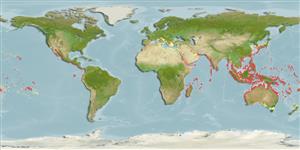Common names from other countries
Environment: milieu / climate zone / depth range / distribution range
Ecología
; rango de profundidad 0 - 25 m (Ref. 349). Tropical
Indo-Pacific and the Mediterranean.
Length at first maturity / Tamaño / Peso / Age
Maturity: Lm ? range ? - ? cm Max length : 2.5 cm SHL macho / no sexado; (Ref. 349); common length : 2.0 cm SHL macho / no sexado; (Ref. 349)
Collected for food and for its shell (Ref. 349). Abundant in sheltered bays. Leaves meandering tracks at low tide on sandy shores. Occurs at the low tide mark (Ref. 349); or from immediate subtidal to 20 m in shelly sand (Ref. 337). Attacks bivalve prey through the umbo or valve center (Ref. 100855).
Life cycle and mating behavior
Madurez | Reproducción | Puesta | Huevos | Fecundidad | Larva
Members of the order Neotaenioglossa are mostly gonochoric and broadcast spawners. Life cycle: Embryos develop into planktonic trocophore larvae and later into juvenile veligers before becoming fully grown adults.
Poutiers, J.M. 1998. (Ref. 349)
IUCN Red List Status (Ref. 130435)
CITES status (Ref. 108899)
Not Evaluated
Not Evaluated
Human uses
| FishSource |
Herramientas
Más información
Age/SizeCrecimientoLength-weightLength-lengthMorfologíaLarvaAbundancia
Fuentes de Internet
Estimates based on models
Preferred temperature
(Ref.
115969): 22.9 - 29.2, mean 28.3 (based on 3791 cells).
Vulnerability
Low vulnerability (10 of 100).
Price category
Unknown.
